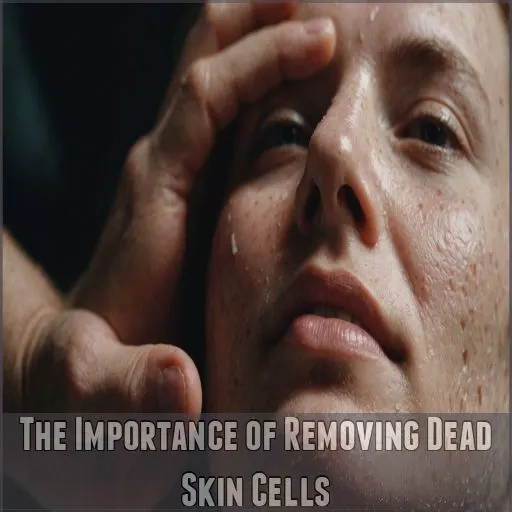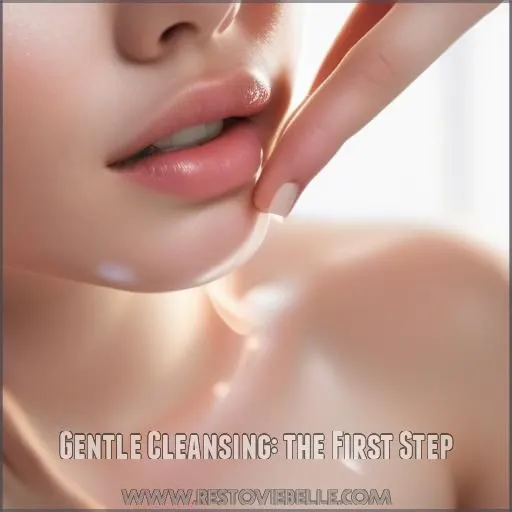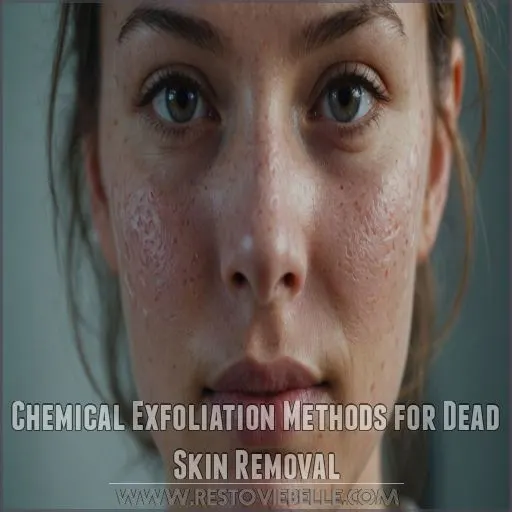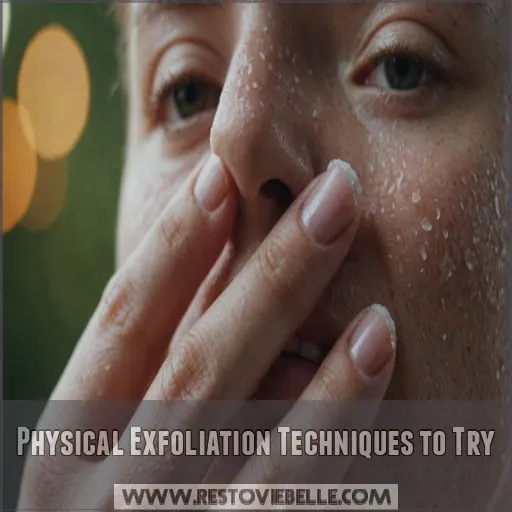This site is supported by our readers. We may earn a commission, at no cost to you, if you purchase through links.
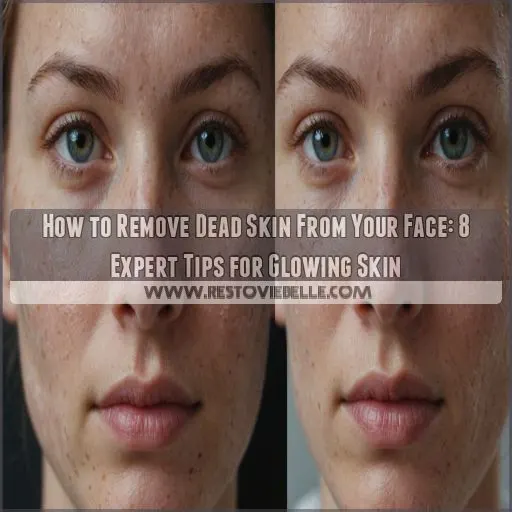
Then, try a chemical exfoliant with alpha hydroxy acids (AHAs) or beta hydroxy acids (BHAs) to dissolve dead cells. For a physical boost, use a soft brush or washcloth in circular motions.
Just don’t overdo it – your skin needs a little TLC, not a full-on assault. Once you’ve sloughed off the dull stuff, lock in moisture with a nourishing moisturizer. Your fresh, radiant complexion will thank you!
Table Of Contents
- Key Takeaways
- The Importance of Removing Dead Skin Cells
- Gentle Cleansing: the First Step
- Chemical Exfoliation Methods for Dead Skin Removal
- Physical Exfoliation Techniques to Try
- Frequently Asked Questions (FAQs)
- How to remove dead skin?
- How to get rid of fat on one side of the face?
- How do I get rid of dead skin on my face?
- How to prevent dead skin on the face?
- How do you get rid of dead skin on your face?
- How do I exfoliate my face?
- Is it okay to peel dead skin off face?
- Is it good to rub dead skin off face?
- How often should I exfoliate my skin?
- What are common signs of over-exfoliation?
- Can sensitive skin benefit from exfoliation?
- Are DIY exfoliants effective for dead skin removal?
- How does exfoliation affect skin hydration?
- Conclusion
Key Takeaways
- Start with a gentle cleanse to set the stage for exfoliation. Your face isn’t a cast-iron skillet; it needs a soft touch to wipe away everyday grime, leaving a clean canvas to work with.
- Explore chemical exfoliants like AHAs or BHAs, which are like tiny erasers for dead skin. They dissolve those pesky old cells without the need for heavy-duty scrubbing. Just remember that your skin will appreciate a cautious approach—don’t dive in headfirst.
- Physical exfoliation adds an extra boost. Think of it as a mini spa session at home with soft brushes or DIY scrubs. Be gentle; your skin responds better to a massage than to a machete.
- Lock in moisture with a nourishing moisturizer to keep that fresh, radiant glow alive. It’s like giving your skin the final cherry on top of its sundae, ensuring that it’s hydrated and happy.
The Importance of Removing Dead Skin Cells
You mightn’t realize it, but your face is constantly shedding dead skin cells.
Removing these cells through regular exfoliation can reveal fresher, more radiant skin underneath.
Help prevent clogged pores that lead to breakouts by utilizing the benefits of regular exfoliation and charcoal’s detoxifying properties
.
Benefits for Skin Health and Appearance
The quest for radiant skin often leads us down the path of exfoliation, discovering the best exfoliants for dry skin
. Removing dead skin cells from your face isn’t just about vanity—it’s a game-changer for your skin’s health and appearance.
By sloughing off that dull layer, you’re opening up a world of benefits:
- A smoother, more touchable complexion
- A natural, healthy glow that turns heads
- Improved absorption of skincare products
Regular exfoliation can even out your skin tone, reduce breakouts, and minimize the appearance of pores. It’s like giving your face a fresh start, revealing the vibrant you beneath.
How Dead Skin Accumulates on the Face
Your skin’s daily grind can leave it looking less than stellar. Dead skin cells accumulate on your face due to various factors, creating a dull complexion.
Let’s break down the culprits:
| Cause | Impact | Solution |
|---|---|---|
| Sun damage | Accelerates cell death | Sunscreen |
| Pollution | Clogs pores | Deep cleansing |
| Makeup residue | Traps dead cells | Double cleansing |
| Age factors | Slows cell turnover | Gentle exfoliation |
| Skincare routine | Inadequate removal | Regular exfoliation |
Don’t let these factors dim your glow! A proper skincare routine can help you shed that dead weight (Source).
Frequency of Natural Skin Cell Turnover
Every few weeks, your face gets a fresh start. Your skin cell turnover rate—the time it takes for new cells to replace old ones—is like nature’s own makeover schedule.
- Age (slows down as you get older)
- Diet and nutrition
- Sleep quality
- Stress levels
- Environmental factors like sun exposure
Understanding this process is key to maintaining that healthy glow. Think of your skin as a natural sponge, constantly renewing itself to keep you looking your best.
Consequences of Not Removing Dead Skin
Ever wonder what happens when you skip exfoliation? Brace yourself for a skin rebellion!
Without regular dead skin removal, you’re inviting a host of uninvited guests: clogged pores, a dull complexion, and uneven tone . Your face might even throw a tantrum with acne breakouts .
Worse yet, those stubborn dead cells can accelerate premature aging, making fine lines more noticeable. Don’t let your skin suffer in silence – it’s time to shed those old layers!
Gentle Cleansing: the First Step
Before you start sloughing off those dead skin cells, it’s essential to prep your face with a gentle cleanse.
This essential first step sets the stage for effective exfoliation by removing surface dirt and oils, allowing you to tackle dead skin removal with a clean canvas.
Choosing the Right Facial Cleanser
Picking up the right facial cleanser can make or break your skincare routine, especially when it comes to oily skin cleansing
. It’s the foundation for healthy, glowing skin.
To choose wisely, consider these key factors:
- Your skin type (oily, dry, combination, or sensitive)
- Cleanser ingredients (look for gentle, non-irritating formulas)
- pH balance (aim for slightly acidic to maintain skin barrier)
- Texture preference (gel, foam, cream, or oil)
Remember, a good cleanser should remove dirt and oil without stripping your skin’s natural moisture.
Proper Cleansing Techniques for Different Skin Types
Your skin’s unique needs dictate the best cleansing approach.
For dry skin, opt for a gentle, non-foaming cleanser to preserve natural oils . If you’re battling oiliness, look for oil-free formulas that deep clean without over-drying.
Sensitive types should steer clear of fragrances and harsh ingredients.
Combination skin? Try the "multi-mask" method – use different cleansers on oily and dry areas.
Remember, your face isn’t a chalkboard – no need to scrub aggressively!
Water Temperature and Its Impact on Skin
Water temperature plays a key role in your cleansing routine.
While you might think hot water opens pores and cold water closes them, that’s not quite how it works.
Lukewarm water is your best bet for maintaining skin health . It helps your cleanser work effectively, and balances natural oils without stripping your skin.
Hot water can dry out your face, while cold water may boost circulation and reduce inflammation.
Pat Drying Vs. Rubbing the Face
The gentle touch can make all the difference in drying your face. After cleansing, resist the urge to vigorously rub with your towel.
Instead, opt for a soft patting motion to remove excess water . This technique helps prevent irritation and inflammation, especially if you have sensitive skin.
Remember, your face isn’t a kitchen counter – treat it with kid gloves for that coveted healthy glow.
Chemical Exfoliation Methods for Dead Skin Removal
Tired of dull, lifeless skin?
Chemical exfoliants like alpha hydroxy acids, beta hydroxy acids, and retinoids can work wonders in sloughing off that pesky dead skin.
Just be sure to choose the right one for your skin type – your complexion will thank you!
Alpha Hydroxy Acids (AHAs) and Their Benefits
Alpha Hydroxy Acids, or AHAs, are your skin’s best friend for exfoliation. They gently nudge dead skin cells off your face, revealing a fresher, brighter complexion underneath.
AHAs can tackle acne and sensitive skin while smoothing fine lines. However, don’t go overboard—using too much can irritate.
Find a product that fits your needs and enjoy glowing skin.
Beta Hydroxy Acids (BHAs) for Oily Skin
Looking for a game-changer in your skincare routine?
BHAs might be your best bet if your skin’s got a little too much shine. These oil-dissolving acids go deep, unclogging congested pores and tackling excess sebum.
Unlike AHAs, BHAs offer exfoliation without the potential irritation—perfect for oily skin.
Embrace smoother, happier skin with BHA products! (Source).
Enzyme Exfoliants and Their Gentle Action
Imagine your skin glowing like a freshly polished apple after using enzyme exfoliants. These gentle marvels break down dead skin without harming your skin’s sensitive layers. Perfect for those with delicate skin, enzymes offer benefits without the sting of acids.
- Enzymes maintain your skin’s natural pH balance.
- Ideal for sensitive skin and beginners.
- Derived from fruits like papaya and pineapple.
Retinoids for Cellular Turnover and Exfoliation
Retinoids, the superheroes of skincare, boost your skin’s cell turnover and help shed that dull layer of dead skin.
Whether you choose retinol, tretinoin, or adapalene, these vitamin A derivatives rejuvenate your skin like magic.
Just remember: start slow to avoid irritation—your skin might throw a little tantrum at first . Who knew wrinkle-fighting could be so thrilling?
Selecting the Right Chemical Exfoliant for Your Skin Type
You’ve explored retinoids; now, let’s pick the right chemical exfoliant for your skin type.
Choosing between AHA and BHA? AHAs like glycolic acid suit dry skin, while BHAs like salicylic acid excel for oily skin .
Start with a lower concentration and always patch test first.
Remember, reading ingredient labels is like decoding a skincare treasure map!
Physical Exfoliation Techniques to Try
Now that you’ve explored chemical exfoliation, let’s get your hands into the art of physical exfoliation! Imagine treating your face to a gentle massage with exfoliating tools like facial brushes and exfoliating gloves, which can slough off dead skin with ease.
Ever tried DIY scrubs made from sugar or oats? They’re cost-effective and quite satisfying for those who love a bit of pampering.
If you’re after something less hands-on, microdermabrasion at a spa offers a professional touch . Remember to be gentle with your skin; circular motions with light pressure are your best friends.
After all this exfoliating fun, you’ll love how smooth your skin feels—like a fresh start every time!
Frequently Asked Questions (FAQs)
How to remove dead skin?
To remove dead skin, consider gentle scrubs with ingredients like oatmeal or yogurt for sensitive skin.
For a more efficient approach, try chemical exfoliants, such as lactic acid.
Always check with a dermatologist for personalized advice.
How to get rid of fat on one side of the face?
For a fabulous facial fix, consider facial exercises, massages, or contouring makeup.
If you’re seeking surgical solutions, consult a specialist for options like fat transfer or reduction techniques, all aiming for a balanced, beautiful visage .
How do I get rid of dead skin on my face?
Gently exfoliate your face using either a mild scrub with oatmeal or a chemical exfoliant like yogurt, which contains lactic acid, a gentle ingredient for sensitive skin
.
Just remember, don’t overdo it—your skin will thank you for taking it easy! .
How to prevent dead skin on the face?
Keep your skin vibrant by using gentle cleansers, moisturizing daily, and exfoliating weekly with AHAs or BHAs.
Avoid harsh products, hot water, and sun overexposure.
Staying hydrated and using sunscreen also help prevent dead skin buildup (Source).
How do you get rid of dead skin on your face?
Exfoliate your face by gently massaging with a mix of ground oats and yogurt for sensitive skin.
Try a lactic acid-rich yogurt mask.
Always moisturize after and avoid broken skin areas for best results.
How do I exfoliate my face?
Boost your skin’s radiance with a little elbow grease!
Gently exfoliate your face using a homemade scrub packed with nourishing ingredients like oatmeal or yogurt check out these homemade scrub recipes
.
Reveal a smoother, brighter complexion in no time – your skin will thank you!
Is it okay to peel dead skin off face?
Avoid peeling dead skin off your face; it can cause irritation or infection.
Let it slough off naturally. Moisturizing regularly helps with healing and minimizes visible peeling.
Be patient; your skin’s doing its thing!
Is it good to rub dead skin off face?
Think of your face as a canvas; gentle exfoliation is like a fine brushstroke revealing fresh skin underneath.
Use chemical exfoliants cautiously, avoiding harsh scrubs to prevent irritation and achieve glowing, healthy skin through gentle means, such as chemical exfoliants.
How often should I exfoliate my skin?
Exfoliate your face two to three times a week, depending on skin sensitivity, using chemical exfoliants for frequent use.
Physical exfoliants might require less frequent application to avoid irritation on sensitive skin types.
What are common signs of over-exfoliation?
Over-exfoliating leaves your skin feeling overly sensitive, red, or irritated, like it’s throwing a tantrum.
You might notice flakiness, breakouts, or dryness—your skin’s SOS signal to ease up on the scrubbing.
Can sensitive skin benefit from exfoliation?
Dancing with your delicate skin, gentle exfoliation can boost radiance and clarity.
Opt for mild chemical exfoliants like PHAs for their soft touch, helping you shed dead cells without ruffling feathers, leaving your skin feeling refreshed.
Are DIY exfoliants effective for dead skin removal?
Sure, DIY exfoliants can kick dead skin to the curb!
These mixes like oatmeal or brown sugar scrubs are effective and often safer than store-bought options.
Always test them gently since ingredients vary in strength.
How does exfoliation affect skin hydration?
Exfoliation is the key to boosting your skin’s hydration potential. By sloughing off dead cells, you open the door for thirsty skin to soak up nourishing ingredients like hyaluronic acid.
Conclusion
Who knew removing dead skin from your face could sound like a spa day rather than yard work?
By focusing on gentle cleansing, mastering chemical and physical exfoliation, and remembering to moisturize, you’re on track to achieve that radiant complexion you’ve been pining for.
Stick to these expert tips, and your mirror will thank you with a glowing smile every day.
Plus, you might find your friends asking for your secret skincare superhero routine!

